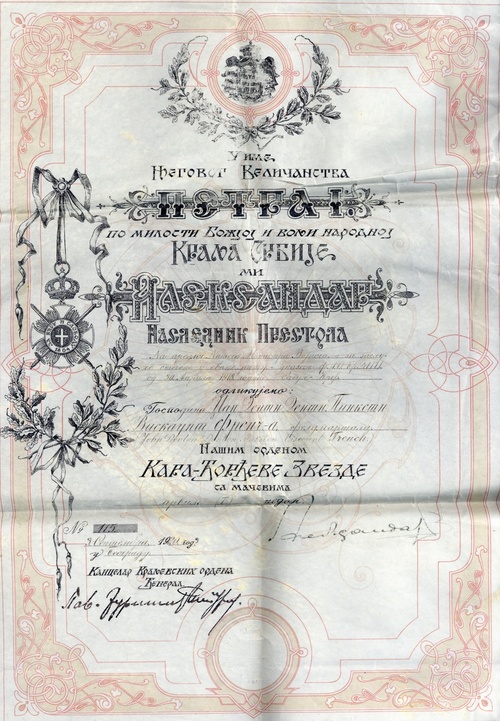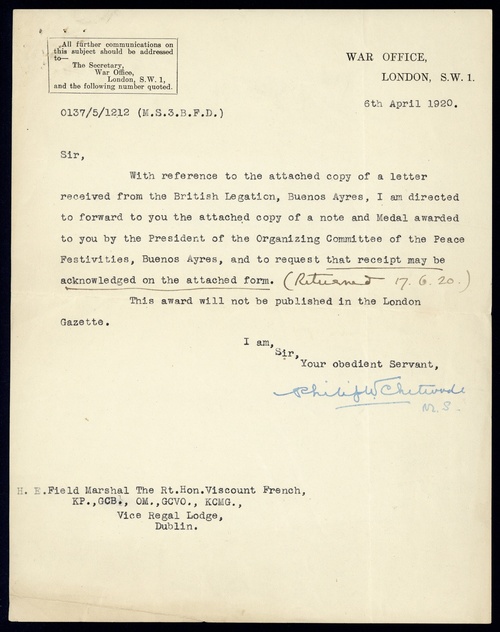Auction: 19003 - Orders, Decorations and Medals
Lot: 625
A fine collection of documents and artefacts of Field Marshal Sir John Denton Pinkstone French, first Earl of Ypres, K.P., G.C.B., O.M., G.C.V.O., K.C.M.G.
Comprising:
(i)
Parchment warrant for the award of the Serbian Order of Karageorge: a finely-decorated certificate depicting the insignia of the order, delicate coloured borders and black text with additional detail in ink showing issue to Viscount French & with dates August 1918 and 1920. 380mm x 500mm, folded
(ii)
Correspondence concerning the award of an Argentine peace medal. Copy of letter from the British Legation at Buenos Ayres to Lord Curzon forwarding six medals and award certificates: “These Medals and Notes have been sent to me by Mr. Adolfo Mugica… in his capacity as President of the Organizing Committee of the Peace Festivities… which were held in this City after the signing of the Treaty of Peace…” The six designated recipients were H.M. The King, Mr. Lloyd George, David Beatty, Douglas Haig, John French and Sir Reginald Tower. The certificate for French’s medal is present, together with a signed letter from the Military Secretary at the War Office, Philip Chetwode [Field Marshal Sir Philip Walhouse Chetwode], forwarding both and requesting acknowledgment which French has done, noting “(Returned 17.6.20).”
(iii)
Notes for eight speeches delivered by Sir John French 1910-24, including R.M.C. Kingston, June 1910; Mansion House Nov. 1910; Staff College, Dec. 1913 &c., various sizes, approx. 70pp. in all
(iv)
Approximately thirty telegrams largely dating from French’s governorship of Ireland 1918-21, offering or acknowledging congratulations
(v)
A small photograph of French in South Africa
(vi)
A most unusual Arts & Crafts style oak presentation casket, probably originally containing a Freedom Scroll or an address of welcome, the top lid having an ornate applied enamelled plaque bearing the arms, crest and motto of French, brass furniture in the form of strapwork, square catches secured by sliding bolts attached by chains, the brass corner mounts decorated with silver and enamel scallop shells and fish, the sides additionally decorated with attached chains which form the handles. The casket stands on octagonal brass feet, signs of old polishing and one bolt and chain an old replacement to this last, otherwise good condition overall (Lot)
The arms are for those of French impaling Selby-Lowndes, for in 1880 he married Eleonora Selby-Lowndes; the motto ‘Malo Mori quam foedari’ (‘I would rather die than be dishonoured’) and the crest, a dolphin embowed, are also correct for French.
John Denton Pinkstone French was born in Ripple Vale, near Deal, Kent, on 28 September 1852. After two years at the Royal Naval College, Dartmouth, he entered the Royal Navy as a midshipman in 1868. Resigning from the Navy in 1870, he was commissioned supernumerary Lieutenant in the Suffolk Artillery Militia in 1872, from which he was commissioned Lieutenant in the 8th (King's Royal Irish) Hussars in 1874, transferring in the same year to the 19th (Princess of Wales's Own) Hussars. He remained with the 19th Hussars for the next nineteen years, being promoted Captain in 1880 and Major in 1883 and commanding the regiment in the rank of Lieutenant-Colonel from 1888 until 1893. He served with distinction in Wolseley's attempt to relieve the besieged General Gordon in Khartoum in 1884-85 and took the 19th Hussars to India in 1889. In the substantive rank of Colonel in 1895, French was appointed Assistant Adjutant-General at the War Office and was subsequently posted to command, first, the 2nd Cavalry Brigade at Canterbury in 1897 and, second, the 1st Cavalry Brigade at Aldershot in 1899.
On the outbreak of the South African War in 1899 French was appointed to command the cavalry in Natal in the temporary rank of Major-General but his command was subsequently extended to cover the Cavalry Division throughout the campaigning area and he was given the local rank of Lieutenant-General late in 1899. French's cavalry distinguished itself at the battle of Elandslaagte in October 1899 and he subsequently escaped from Ladysmith just before the Boers sealed the perimeter of the besieged town in November 1899. By early 1900, Ladysmith, Mafeking and Kimberley were all besieged and being bombarded by Boer forces; one of the initial tasks of the newly-appointed Commander-in-Chief in South Africa, Field Marshal Lord Roberts, was to engineer the relief of those sieges. French took 4,000 cavalry across the Riet and Modder Rivers and, charging through thinly-held Boer positions at Klip Drift, his force relieved the siege of Kimberley on 15 February 1900. The remainder of the South African War saw French's cavalry in action at Poplar Grove later in 1900 and at the captures of Middelburg in July and Barberton in September 1900. As the war became more 'guerrilla' in nature, French commanded in the Johannesburg district in November 1900 and in Cape Colony from June 1901. He was promoted substantive Major-General in 1900 and appointed a Knight Commander of the Order of the Bath (K.C.B.) in recognition of his services in the early part of the war. On his return home, in August 1902, he was promoted Lieutenant-General and appointed a Knight Commander of the Order of St. Michael and St. George (K.C.M.G.).
The South African War had brought French into the public spotlight as one of the more successful commanders of the campaign against the Boers, and his subsequent career reflected this. Appointed to command at Aldershot in September 1902 and joining the Committee of Imperial Defence in December 1905, French was promoted General in February 1907 and appointed a Knight Grand Cross of the Royal Victorian Order (G.C.V.O.). In November 1907 he was appointed Inspector-General of the Forces and held the appointment of A.D.C. to The King 1911-13. Having achieved a reputation as a dynamic moderniser, French was appointed Chief of the Imperial General Staff in March 1912 and promoted Field Marshal in June 1913. He was the natural choice to command the British Expeditionary Force in France and Flanders on the outbreak of the First World War in August 1914.
French remained in command of the B.E.F. - which had grown into two Army Groups by December 1914 - until December 1915, by which time confidence in his handling of the British part of the war had diminished. On his return home, he was appointed Commander-in-Chief Home Forces and created Viscount French of Ypres. His handling of home defence proved generally sound and he held an unofficial position as strategic adviser to the Prime Minister, Lloyd George, before being appointed Lord Lieutenant of Ireland in May 1918, a position that he retained until April 1921, after which he was created Earl of Ypres. His last appointment was as Constable of Deal Castle in August 1923 and he died there in May 1925.
French's career has undergone historical analysis from the time of his death until the present day, the current informed opinion being that, a product of the 19th century 'cavalry school' of warfare, he was temperamentally and intellectually unsuited to the challenges of mass 20th century warfare. He was, though, not among the 'butcher and bungler' Generals so much caricatured from the 1930s to the 1960s and has been less chastised in death than has Haig, with whom he served for many years in a variety of roles. His extensive collection of Orders of Chivalry and decorations are in the collections of the Imperial War Museum, as are most of his papers.
Subject to 20% VAT on Buyer’s Premium. For more information please view Terms and Conditions for Buyers.
Sold for
£650
Starting price
£480







